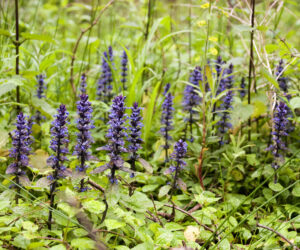Bugle is a native perennial, herbaceous flowering plant belonging to the mint family. It is found in rough pasture, waste ground and damp deciduous woodlands. In spring, the plant sends up 10–15 cm tall flower stalks bearing many small purple flowers, which are very recognisable.
Behaviour
Bugle propagates mainly by growing surface runners (which are known as stolons). Large dark green oval leaves spread out in a rosette at the base of the sprouting stem which has a square cross section and is hairy. Smaller leaves grow up the flower stem which are in opposite pairs. The clusters of flowers resemble whorls, with four to six purple/blue flowers arranged in terminal spikes. The spike elongates as flowers open from the bottom upward. Flowers are replaced by nutlet fruits in the late summer.
The species is monoecious, with male and female flowers on the same plant.
Size
- Height: 10-35 cm
Status
Green; Least concern
Distribution
Common and widespread wildflower across Great Britain, except the very north and west of Scotland.
When to see
April – July (when in bloom)
Facts
- Bugle is also known as “carpenter’s herb” due to its supposed ability to stem bleeding.
- The Bugle’s flowers are fantastic for insects, such as the white-tailed bumblebees and green-veined white butterflies.

